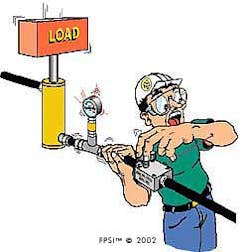High-pressure hydraulic operations can pose dangers if proper safety precautions are not taken. Recently, a machine operator was fatally injured attempting to bleed trapped air from a hydraulic cylinder on an automated forming machine. The Fluid Power Safety Institute (FPSI) made an unofficial assessment of the situation to determine what went wrong.
The incident involved high-pressure hydraulic oil being injected into the operator’s hand as he opened a bleed-to-atmosphere type air-bleed valve on a hydraulic cylinder. The first thing the FPSI recognized is improper procedure; attempting to bleed air from the system should be the job of a trained maintenance worker. But with high production demands, the team was in a hurry, and the operator attempted to perform basic service and repairs, even though he never had training.
The FPSI recommends that plants train everyone who works around hydraulic systems. This includes operators, supervisors, and plant managers. Then, only personnel that is trained and authorized should be able to execute service and maintenance functions. In this case, only maintenance personnel had on-the-job training in hydraulics—air-bleed training was not enforced for operators, mechanics, or supervisors.
There was no job safety breakdown or job safety analysis (JSA) ever written for the procedure either. The FPSI recommends qualified persons write JSAs for all "special skills" tasks. "Closed-circuit" pressure verification and bleed-down devices should also be installed in areas where energy can be stored in hydraulic systems.
The FPSI also learned that similar incidents while bleeding trapped air from a hydraulic system had happened before, but went unreported. Generally, manual bleed-to-atmosphere air-bleed devices tend to lend themselves to this kind of accident. Even a trained person is at risk. Alternative air-bleed devices, such as automatic air-bleed valves, closed-loop ball-valves, or Safe-T-Bleed can be used to avoid these incidents. Safe-T-Bleed allows bleeding air to be let out of cylinders, pumps, accumulators, transmission lines without any manual opening of the system to atmosphere.
This information is adapted from Fluid Power Safety Alerts with permission of the Fluid Power Safety Institute.


